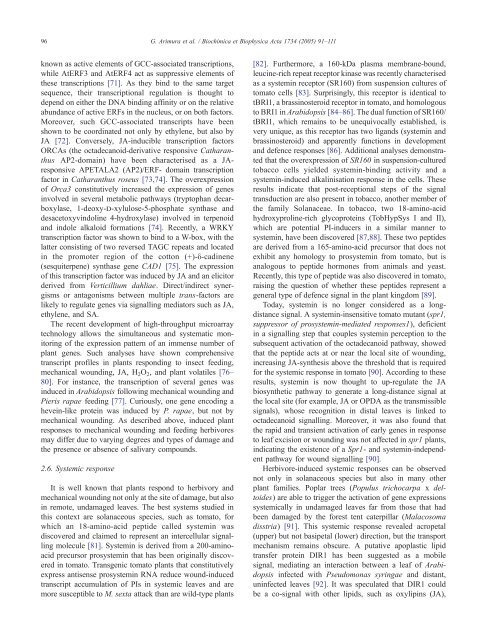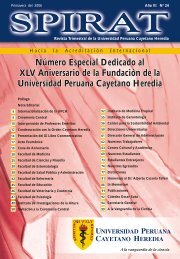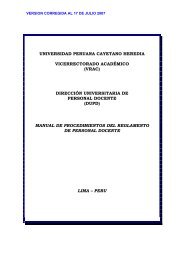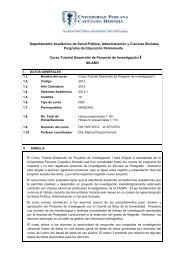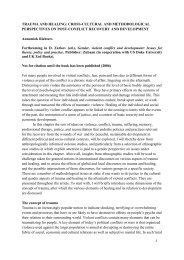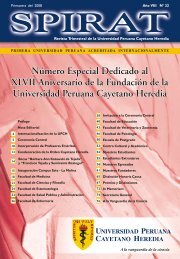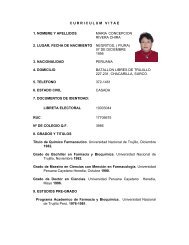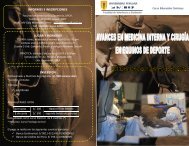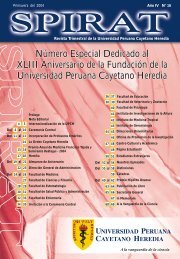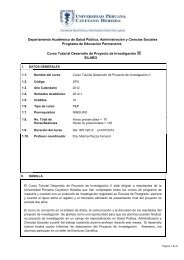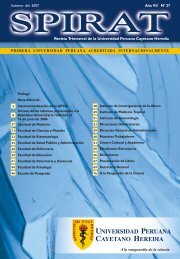Herbivore-induced, indirect plant defences - UPCH
Herbivore-induced, indirect plant defences - UPCH
Herbivore-induced, indirect plant defences - UPCH
You also want an ePaper? Increase the reach of your titles
YUMPU automatically turns print PDFs into web optimized ePapers that Google loves.
96G. Arimura et al. / Biochimica et Biophysica Acta 1734 (2005) 91–111known as active elements of GCC-associated transcriptions,while AtERF3 and AtERF4 act as suppressive elements ofthese transcriptions [71]. As they bind to the same targetsequence, their transcriptional regulation is thought todepend on either the DNA binding affinity or on the relativeabundance of active ERFs in the nucleus, or on both factors.Moreover, such GCC-associated transcripts have beenshown to be coordinated not only by ethylene, but also byJA [72]. Conversely, JA-inducible transcription factorsORCAs (the octadecanoid-derivative responsive CatharanthusAP2-domain) have been characterised as a JAresponsiveAPETALA2 (AP2)/ERF- domain transcriptionfactor in Catharanthus roseus [73,74]. The overexpressionof Orca3 constitutively increased the expression of genesinvolved in several metabolic pathways (tryptophan decarboxylase,1-deoxy-d-xylulose-5-phosphate synthase anddesacetoxyvindoline 4-hydroxylase) involved in terpenoidand indole alkaloid formations [74]. Recently, a WRKYtranscription factor was shown to bind to a W-box, with thelatter consisting of two reversed TAGC repeats and locatedin the promoter region of the cotton (+)-y-cadinene(sesquiterpene) synthase gene CAD1 [75]. The expressionof this transcription factor was <strong>induced</strong> by JA and an elicitorderived from Verticillium dahliae. Direct/<strong>indirect</strong> synergismsor antagonisms between multiple trans-factors arelikely to regulate genes via signalling mediators such as JA,ethylene, and SA.The recent development of high-throughput microarraytechnology allows the simultaneous and systematic monitoringof the expression pattern of an immense number of<strong>plant</strong> genes. Such analyses have shown comprehensivetranscript profiles in <strong>plant</strong>s responding to insect feeding,mechanical wounding, JA, H 2 O 2 , and <strong>plant</strong> volatiles [76–80]. For instance, the transcription of several genes was<strong>induced</strong> in Arabidopsis following mechanical wounding andPieris rapae feeding [77]. Curiously, one gene encoding ahevein-like protein was <strong>induced</strong> by P. rapae, but not bymechanical wounding. As described above, <strong>induced</strong> <strong>plant</strong>responses to mechanical wounding and feeding herbivoresmay differ due to varying degrees and types of damage andthe presence or absence of salivary compounds.2.6. Systemic responseIt is well known that <strong>plant</strong>s respond to herbivory andmechanical wounding not only at the site of damage, but alsoin remote, undamaged leaves. The best systems studied inthis context are solanaceous species, such as tomato, forwhich an 18-amino-acid peptide called systemin wasdiscovered and claimed to represent an intercellular signallingmolecule [81]. Systemin is derived from a 200-aminoacidprecursor prosystemin that has been originally discoveredin tomato. Transgenic tomato <strong>plant</strong>s that constitutivelyexpress antisense prosystemin RNA reduce wound-<strong>induced</strong>transcript accumulation of PIs in systemic leaves and aremore susceptible to M. sexta attack than are wild-type <strong>plant</strong>s[82]. Furthermore, a 160-kDa plasma membrane-bound,leucine-rich repeat receptor kinase was recently characterisedas a systemin receptor (SR160) from suspension cultures oftomato cells [83]. Surprisingly, this receptor is identical totBRI1, a brassinosteroid receptor in tomato, and homologousto BRI1 in Arabidopsis [84–86]. The dual function of SR160/tBRI1, which remains to be unequivocally established, isvery unique, as this receptor has two ligands (systemin andbrassinosteroid) and apparently functions in developmentand defence responses [86]. Additional analyses demonstratedthat the overexpression of SR160 in suspension-culturedtobacco cells yielded systemin-binding activity and asystemin-<strong>induced</strong> alkalinisation response in the cells. Theseresults indicate that post-receptional steps of the signaltransduction are also present in tobacco, another member ofthe family Solanaceae. In tobacco, two 18-amino-acidhydroxyproline-rich glycoproteins (TobHypSys I and II),which are potential PI-inducers in a similar manner tosystemin, have been discovered [87,88]. These two peptidesare derived from a 165-amino-acid precursor that does notexhibit any homology to prosystemin from tomato, but isanalogous to peptide hormones from animals and yeast.Recently, this type of peptide was also discovered in tomato,raising the question of whether these peptides represent ageneral type of defence signal in the <strong>plant</strong> kingdom [89].Today, systemin is no longer considered as a longdistancesignal. A systemin-insensitive tomato mutant (spr1,suppressor of prosystemin-mediated responses1), deficientin a signalling step that couples systemin perception to thesubsequent activation of the octadecanoid pathway, showedthat the peptide acts at or near the local site of wounding,increasing JA-synthesis above the threshold that is requiredfor the systemic response in tomato [90]. According to theseresults, systemin is now thought to up-regulate the JAbiosynthetic pathway to generate a long-distance signal atthe local site (for example, JA or OPDA as the transmissiblesignals), whose recognition in distal leaves is linked tooctadecanoid signalling. Moreover, it was also found thatthe rapid and transient activation of early genes in responseto leaf excision or wounding was not affected in spr1 <strong>plant</strong>s,indicating the existence of a Spr1- and systemin-independentpathway for wound signalling [90].<strong>Herbivore</strong>-<strong>induced</strong> systemic responses can be observednot only in solanaceous species but also in many other<strong>plant</strong> families. Poplar trees (Populus trichocarpa x deltoides)are able to trigger the activation of gene expressionssystemically in undamaged leaves far from those that hadbeen damaged by the forest tent caterpillar (Malacosomadisstria) [91]. This systemic response revealed acropetal(upper) but not basipetal (lower) direction, but the transportmechanism remains obscure. A putative apoplastic lipidtransfer protein DIR1 has been suggested as a mobilesignal, mediating an interaction between a leaf of Arabidopsisinfected with Pseudomonas syringae and distant,uninfected leaves [92]. It was speculated that DIR1 couldbe a co-signal with other lipids, such as oxylipins (JA),


